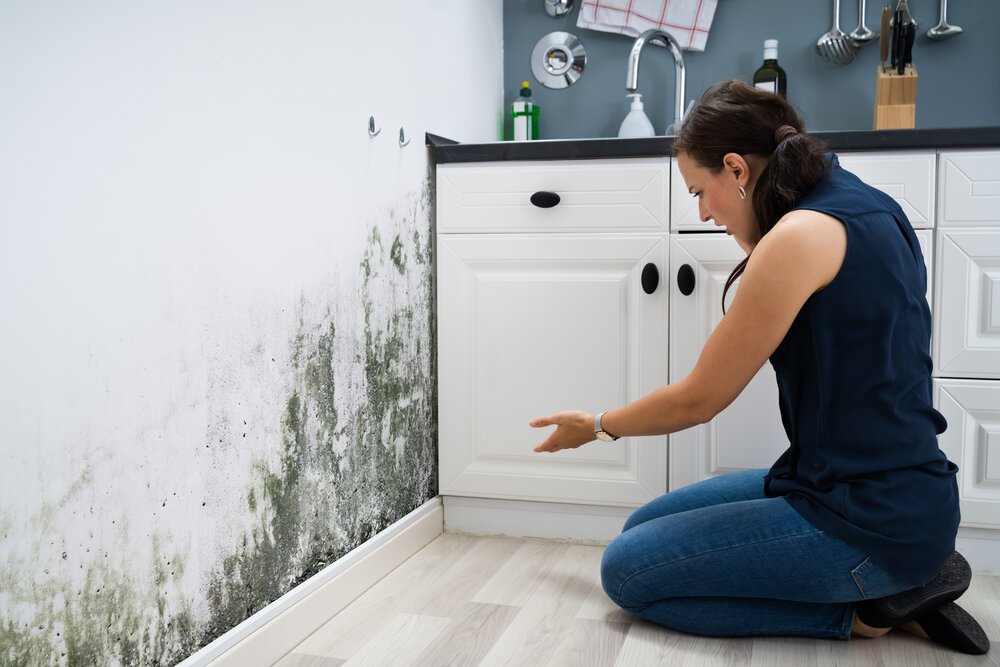What are the Short- and Long-Term Effects of Toxic Mold Exposure?

Mold exposure can cause a variety of health problems — some of which may be serious — which is why remediation is so important. In this guide, we outline the common short- and long-term effects of toxic mold exposure and give you tips on how to identify mold in your home — and prevent it from occurring in the first place.
-
Symptoms and Reactions to Mold Exposure
-
Short- And Long-Term Effects of Mold Exposure
-
What Is Toxic Mold Syndrome?
-
Mold Risks In Your Home
-
How to Identify Mold
-
Mold Inspection & Mold Testing
-
The Mold Removal Process
-
What To Do If You Have Mold In Your Home
-
How to Prevent Mold Growth
Mold Exposure: Symptoms and Reactions
Prolonged exposure to mold may result in allergy-like symptoms, such as a runny nose and congestion, eye irritation, sneezing, coughing, sore throat, wheezing, and lung irritation, according to Healthline. Other symptoms may include skin rashes and headaches.
A mold rash, or black mold rash, can be difficult to differentiate from other types of rashes, according to Healthline. Symptoms include itchiness, dry and scaly skin, raw and sensitive skin, brown or pink skin, or small raised bumps that may leak fluid. Since this type of rash is similar to others, it’s best to consult a doctor or dermatologist.
Mold also has the potential to trigger an attack for those with asthma. But the symptoms and reactions to exposure will vary from person to person. As the CDC explains: “Exposure to mold may cause a variety of health problems, or no problems at all. Some people are more sensitive than others.”
Short- And Long-Term Effects of Mold Exposure
As we’ve mentioned above, short-term health effects can include a range of allergy-like symptoms.
According to Healthline, you may be a higher risk for complications if you have conditions such as allergies, asthma, COPD, a compromised immune system, or cystic fibrosis.
Medical News Today explains that those with weakened immune systems, such as uncontrolled HIV, those undergoing cancer treatment, etc., are at risk of fungal infections if exposed to mold for prolonged periods of time.
What Is Toxic Mold Syndrome?
According to the CDC, “certain molds are toxigenic, meaning they can produce toxins (specifically ‘mycotoxins’).” More about mold from the CDC: Mold
Mycotoxins, as defined by the World Health Organization, are naturally occurring toxins produced by certain fungi (or mold); they are commonly found growing on certain types of food, including cereal, nuts, spices, dried fruit, apples, and coffee beans.
Though mycotoxins are commonly found in food, they can be found in other parts of the home where mold is present, which is why remediation is so important. But according to the CDC, “There are very few reports that toxigenic molds found inside homes can cause unique or rare health conditions such as pulmonary hemorrhage or memory loss. These case reports are rare, and a causal link between the presence of toxigenic mold and these conditions has not been proven.”
The bottom line: If you have any mold, no matter its color or prevalence, removal is strongly recommended. And if you have any medical issues that you think may be related to mold, it’s best to contact your doctor.
Mold Risks In Your Home
The reality is that everyone is at risk for mold in their home. That’s because mold is a type of fungus that thrives on moisture, and everyone has sources of moisture in their home. You will typically find mold in places where water can enter the home or where condensation can occur, such as:
- Basements
- Attics
- Sinks
- Toilets
- Bathtubs
- Leaky windows
Mold can present practically anywhere in and around your home — including the kitchen, living room, bedroom, roof, and ductwork. You should especially check areas that have been flooded or have high humidity.
How to Identify Mold
Mold comes in a variety of colors: green, red, black, or white. As The Spruce explains, it’s often confused with dirt, typically comes in darker shades, and is fuzzy.
Sometimes mold identification is relatively easy — in other words, it’s visible. When this is the case, you should call a mold remediation company for proper, safe removal. Even if you aren’t sure whether you have mold, you should still call a mold remediation company since they are the experts. They will either identify the mold and outline next steps or recommend mold testing from a certified mold inspector.
Mold Inspection & Mold Testing
There is a difference between a mold inspection and mold testing.
A mold inspection is a visual assessment of an area (or multiple areas) to determine whether mold is present.
Mold testing is when a certified mold inspector conducts scientific air sampling and collects samples that will be analyzed in a lab. This typically takes place when you can’t see the mold but suspect it may be present.
The Mold Removal Process
It depends on the contractor’s workload, but the entire process from the initial phone call to complete removal could take place within one week.
The contractor will remove the mold through one of numerous methods, such as:
- Eliminating impacted materials
- Using chemicals and dry ice treatments
- Dehumidification
- Using hydroxyl generators
- Applying mold-resistant coatings
The process for removal is generally the same no matter what type of mold you have in your home. Most importantly, the only way to prevent future mold growth is to correct the situation that created the mold in the first place, so your contractor will likely discuss this with you to prevent any further problems.
What To Do If You Have Mold In Your Home
The first step is to contact a reputable mold remediation contractor. You may or may not need mold testing, but that’s a discussion you can have during that initial phone call.
It’s also best to try and avoid the contaminated area, if possible.
How to Prevent Mold Growth
The best way to prevent future mold growth is to control moisture and humidity. The CDC offers these tips and best practices:
- Control humidity levels
- Promptly fix leaky roofs, windows, and pipes
- Clean and dry areas after any flooding
- Ventilate shower, laundry, and cooking areas
The EPA also recommends taking steps to prevent condensation and avoiding the installation of carpet in areas where there is continuous moisture.
Do You Have Mold In Your Home? We Can Help!
We know mold is a serious health concern for many homeowners, so if you have any questions, or think you may have it in your home, please give us a call. We’ll come out and inspect the area in question — free of charge!
As an industry leader with more than 35 years of award-winning experience, EnviroVantage specializes in indoor air quality (IAQ) improvements, mold remediation, asbestos abatement, duct cleaning, and more. We have helped thousands of homeowners eliminate problems in their home, including all types of mold.
Contact us today with any questions or for more information!

Are you ready to buy or sell your home?
Whether your offer has just been received or you’re thinking about putting your house up for sale, consider these 15 important questions to ask your home inspector.

Questions?
We’d be happy to answer them — and talk about how EnviroVantage can support your next abatement, demolition, or remediation project.